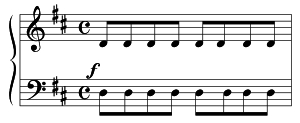We Can Learn from Vivialdi’s “Gloria” How to be Severe and Good Natured
by Alan Shapiro
One of the most popular pieces of choral music is Antonio Vivaldi’s Gloria, written in 1708. It is amazingly short, just about two minutes, and from the first notes of the orchestral introduction, it is propelled. With its cheerful severity, it is a favorite of mine and of choral students I’ve taught. Here is how it begins:
This pattern, with variations in pitch, accompanies nearly every measure of the piece. It is rhythmically and tonally strict; the beat is so definite, yet those bouncing octaves have a sense of release. Imagine that pattern without those octaves. It would be drivingly severe.
The purpose of music, the philosopher Eli Siegel explained, is to like the world itself; and when we care for a particular composition it’s because, in a technical way, it has what we’re looking for in our everyday lives. Vivaldi’s Gloria, in a bold and charming way, says we can be severe and good natured at the same time and for the same purpose—strict and also flexible. And this means it is a useful encouragement and criticism of ourselves.
The piece is marked “allegro,” which means “cheerful” in Italian, and in this case it certainly is. It begins assertively with the full orchestra playing rapid eighth notes. In the first measure, each note is the tonic D—it’s very strict—but there’s a bounce up the octave on the 2nd and 5thnotes of the pattern.
And in the second measure, cheerfulness is accented in the playful 16th notes, but strictness is there too.
Part of the delight of this introduction is that, with all the energetic, speedy cheerfulness, the orchestra soon begins to descend, and then stops severely, abruptly. It seems momentarily lost and looking for something. Then, after 3 beats of silence, as though remembering where it is and finding what it’s looking for, the chorus enters, singing “Gloria” 4 times, forte in bright major chords. Still, there’s a sharp strictness in their dotted rhythm and in the brevity of their phrases.
And what do they sing? “Gloria in excelsis Deo,”—”Glory to God in the highest” again and again, each time differently. In a manner both good natured and insistent, the chorus is singing praise of reality. Is this a criticism of the way a person can meet life dully, respond to things in a soggy, grudging, half-hearted way? I think so. Then, on the words “in excelsis Deo,” something dramatic happens: over the vigorous, staccato orchestral accompaniment, the choir for the first time sings long, legato phrases, moving in slow, sustained half-notes and whole-notes. It is both rousing and comforting.
In his essay “The Criticism of Self,” Eli Siegel writes:
Two purposes must be served by criticism of self: honesty must be satisfied, and encouragement must take place. Criticism of self must be severe and stirring, ruthless and kind. If this is so, criticism of self is like a painting, severe and flowing; a poem, tough and elusive;…music, structural and reassuring.
While the overall effect of the Gloria is undeniably joyous and good natured, a notable fact is that there is something critical too—much of the central portion is more severe as it modulates to minor keys. At times, the harmony is dark, and has a tough, dissonant quality. It does not arrive at good nature by dismissing what is difficult.
Antonio Vivaldi (1675-1741), was both a Catholic priest and a renowned teacher. He instructed, directed and wrote music for the orchestra and choir at the school for orphaned girls in Venice from around 1703-1740; and under his tutelage, these young women developed a wide reputation for their fine musicianship.
In so much of Vivaldi’s music–including his famous “The Four Seasons”—sweet good-nature is at one with strictness and energy. They are in the “Gloria,” and it is a great encouragement for me, including as a teacher and choral director. Many times I’ve gone from being cheerful with my students, even kidding them along, to being exceedingly formal and severe—raising my voice in a harsh, monitory way. I’m fortunate to be learning how to be a better teacher in the Aesthetic Realism Teaching Method workshop and from Chairman of Education Ellen Reiss in professional classes for consultants and associates I have the honor to attend. In one, I said I was distressed about a seventh-grade music class which was very noisy. I would find myself yelling and they would quiet down, but I didn’t feel good about this. Miss Reiss asked:
Do you think these 7th grade students really want to be affected by [music]?…[You can ask] how large is the capacity, also the yearning, to be moved by music?
Alan Shapiro: More perhaps than I’ve thought.
Ellen Reiss: Do you think you come with some prejudice to the 7th grade?—and then there’s raucousness. If they felt you believed in how much they wanted to care for music, if they heard you say: “I don’t know how to meet this situation, and I don’t respect myself when I yell,” something would come through. I think they’re not so mean they wouldn’t meet this.
This discussion—which every teacher should be able to learn from—had a very good effect on me and my students. Vivaldi’s Gloria doesn’t make the mistake I was making—of being either too strict or too ingratiating. As I’m studying his works, it’s clear Vivaldi had a great emotion about the meaning of music, and wanted others to have it. And in the technique of this chorus, he shows there’s honest, logical reason to praise reality because it has a structure that is beautiful and is the same as our most fundamental hope: it puts opposites together.


